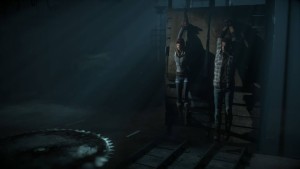Multiple Protagonists
When writing a novel, the author can choose any one of three perspectives from which to tell the story: the first person, the third person limited, and the third person omniscient. For a long time in gaming, writers could not have the same flexibility. The gamer plays as a single character, in the first person perspective. (I should specify that this is not speaking in terms of what the player can see; over-the shoulder games still have a first person narrative. My use of the word “perspective” refers strictly to storytelling.) To play through the narrative in an immersive way, the player assumes the role of one character.
Game creators combatted this limitation with a game-changing invention: the introduction of multiple played protagonists. As gaming technology improved, game makers became capable of producing games that were more complex than ever before. The possibility of multiple protagonists revolutionized gaming and has allowed for countless new storytelling options.
SPOILER WARNING:
In this post, I will be revealing major plot points in some of my favorite games (namely Grand Theft Auto V, Heavy Rain, and Until Dawn). I would rather you skipped reading the blog this week than have your gaming experience ruined if you ever intend to play any of these games. Like, seriously. Ruined. Proceed with caution.
Dramatic Irony
When a game has one protagonist, the player discovers new information at the same rate as the character. If ever the player needs to learn something that the character can’t, a cutscene plays, breaking the immersion both by forcing the player to remove himself from the character and by breaking the rhythm of gameplay. Games with multiple protagonists don’t have this problem. Each individual protagonist can learn different pieces of information, even without the information being shared between characters. The plot of the game Heavy Rain relies entirely on this capability.
In Heavy Rain, the gamer alternates among four different protagonists – Ethan Mars, Madison Paige, Scott Shelby, and Norman Jayden – as they try to reveal the identity of the serial killer who has kidnapped Ethan’s son, Shaun. The appeal of Heavy Rain is that each character uncovers different clues, allowing the player to put the pieces together even if the individual protagonists can’t. The dramatic irony when one character figures it out but the rest are still searching for answers is unparalleled by any game with a single protagonist.
Heavy Rain is an especially fitting example of dramatic irony because one of the protagonists, Scott Shelby, turns out to be the killer. All along while the other three were searching for evidence, Shelby was trying to destroy it. This makes the ending particularly poignant as the player discovers that he was playing the villain all along, and he is forced to watch the characters he’s grown attached to fight it out.
Conflict
Just because they’re all main characters, they don’t all have to get along. Another unique storytelling opportunity presented by multiple protagonist games is the potential for protagonists to fight. In most games, the player will do whatever is best for the protagonist. So what should the player do when protagonists have conflicting interests? This dilemma forces the player to pick favorites and make moral decisions that can impact the well-being (or even survival) of the protagonists.
In the horror game Until Dawn (which has eight playable characters), the gamer is often faced with life-or-death choices that seem to favor one character over another. At one point, the character Chris is the active protagonist, and he must choose to kill either Ashley or Josh with a saw trap. Failing to make a choice could potentially kill both. In another scene, active protagonist Mike must decide whether or not to shoot Emily because she may have been infected with a deadly curse. These are morbid circumstances, surely, but also ingenious storytelling devices.
To bring back an example from a previous blog post, Grand Theft Auto V also forces the player to choose between characters. Close to the climax of the game, the character Franklin is confronted by a decision: he can choose to kill his friend Michael, choose to kill his friend Trevor, or sacrifice himself. In actuality, choosing to sacrifice himself will result in all three surviving, but the player does not know this at the time. In the moment when the player is forced to make a choice, he has to decide his least favorite protagonist, with dramatic consequences on the rest of the narrative.
Game Over… Or Is It?
Obviously the outcomes in some of these situations can be fatal for protagonists, but that doesn’t mean that the game is going to end. In a game with one protagonist, the story must end when the protagonist dies. Game over. Usually the player is returned to a checkpoint and gets to try again. But when there’s more than one protagonist, the game is under no obligation to end just because someone is dead. Life goes on. This outcome is more realistic and doesn’t break the immersion, but it also has a power effect on the player. Watching a character that you’ve grown close to die unexpectedly is dark and unsettling, especially when the other protagonists don’t react. If the other protagonists didn’t know the person who died or aren’t made aware of his death, the player is forced to continue on as if nothing happened, feeling empty, forced to experience the loss alone.
Conclusion – Multiple Protagonists for the Win!
There are countless benefits to having multiple protagonists in a video game, from more storytelling options to the inclusion of dramatic irony and inter-protagonist conflicts. Having more than one protagonist also helps to maintain the immersion, as characters can die, and the game will go on. This all adds up to create a compelling narrative and a more enjoyable gaming experience. It is my personal opinion that games with several playable characters are the future of gaming. Bring on the multiple protagonist games!
Leave a Reply
You must be logged in to post a comment.



2 Responses to “Multiple Protagonists”
I once read an article that objectively tracked the complexity of TV shows and observed that they have gone from single plot lines to multiple intertwined ones. The same trend can be seen in video games, where a huge part of how amazing a game is depends on how amazing of a story it tells. Multiple protagonists, in my opinion, almost always depicts a better and more realistic story, even if the game themes are fantasy. I really enjoy how you not only describe this phenomenon in gaming but also take a stance on it, clearly voicing your opinion. Hopefully your prediction about future games is true! Great work!
Whoa.. mind blown for sure! And some of those plots make me cringe just reading them! That is some twisted stuff, and I can definitely see how it can get a gamer emotionally invested and connected to the game as it caused a response in me just bey reading a summary about it! I think one really cool aspect to the multiple protagonists is that it opens the door for more connection. If the gamer doesn’t like one of the protagonists, like you said, they have a few more to chose from to connect with and become more attached and dedicated to the game. It is definitely a good and interesting strategy.